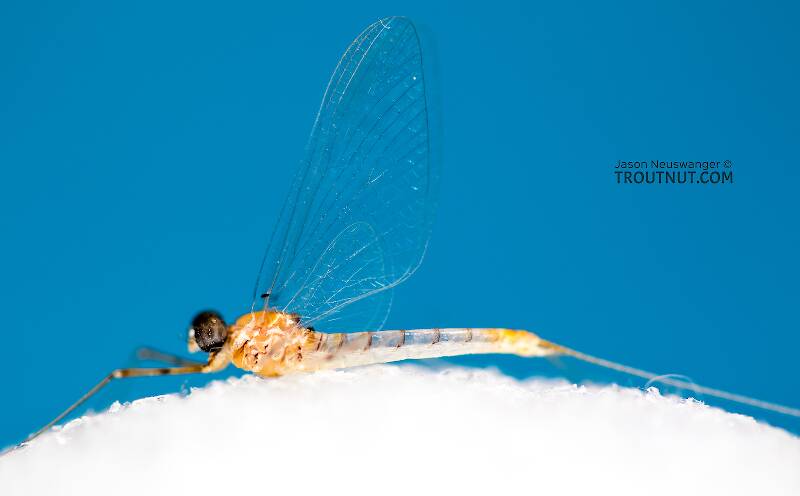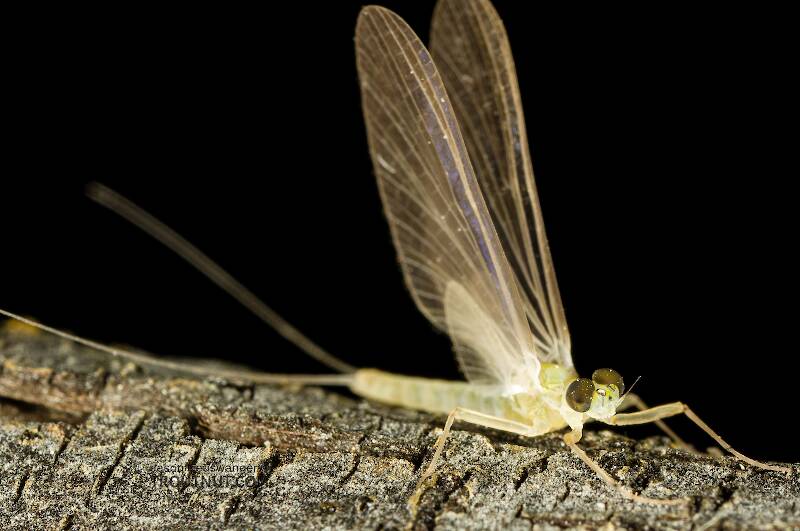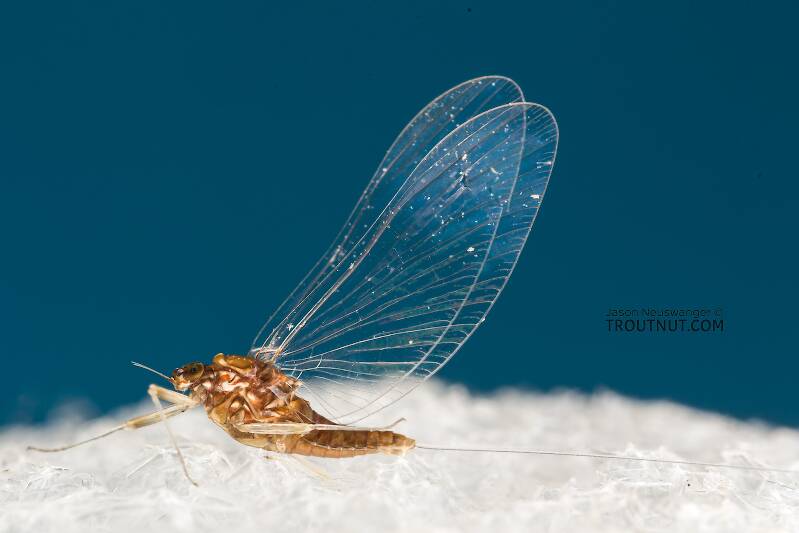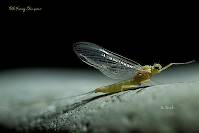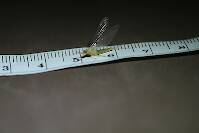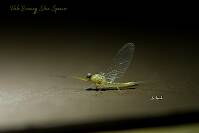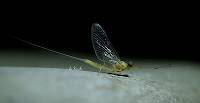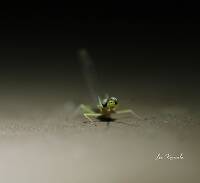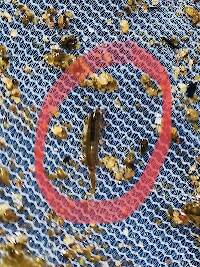
Blue-winged Olives
Baetis
Tiny Baetis mayflies are perhaps the most commonly encountered and imitated by anglers on all American trout streams due to their great abundance, widespread distribution, and trout-friendly emergence habits.
Featured on the forum

Troutnut is a project started in 2003 by salmonid ecologist Jason "Troutnut" Neuswanger to help anglers and
fly tyers unabashedly embrace the entomological side of the sport. Learn more about Troutnut or
support the project for an enhanced experience here.
This topic is about the Insect Order Ephemeroptera
Mayflies may be the most important insects for trout anglers to understand. They are an ancient order of insects, famous outside the fly-fishing world for their fragile beauty and short adult lifespan, often a single day to mate and die. The mayfly's poignant drama attracts poets and anglers alike, but anglers make the most of it.Mayflies live more than 99% of their lives as nymphs on the river or lake bottom, filling many crucial roles in freshwater ecosystems as they feed and grow. They eventually emerge from the water as winged sub-adults called "subimagos" by scientists and "duns" by anglers. Duns evolved to be good at escaping the water, with a hydrophobic surface and hardy build, but they are clumsy fliers. Within a day or two they molt one last time into "imagos" or "spinners," the mature adults, a transformation captured in this photo series of a dun molting into a spinner. They have longer legs and tails, and sleeker, more lightweight bodies, giving them the airborne speed, agility, and long grasp they need for their midair mating rituals. They are usually darker than the duns and have shinier, more transparent wings. They die within minutes or hours after mating.
Example specimens
Taxon on Aug 4, 2011August 4th, 2011, 2:38 pm EDT
Hi Bob-
If you could share your stillwater collection technique(s) for Siphlonorus nymphs, I would be most appreciative.
Sincerely,
If you could share your stillwater collection technique(s) for Siphlonorus nymphs, I would be most appreciative.
Sincerely,
Bnewell on Aug 7, 2011August 7th, 2011, 5:06 pm EDT
Roger,
I have an aquatic net on a 5' handle. It is easy to use and easy to store. For the Siphlonorus I sampled a small lake. I merely ran the net through the vegetation and checked the net contents occasionally until I saw something of interest. Siphlonorus can also be found in flowing water. I recently sampled a small stream using this same net. I hold the net perpendicular to current and disturb rocks upstream from the net.
I have an aquatic net on a 5' handle. It is easy to use and easy to store. For the Siphlonorus I sampled a small lake. I merely ran the net through the vegetation and checked the net contents occasionally until I saw something of interest. Siphlonorus can also be found in flowing water. I recently sampled a small stream using this same net. I hold the net perpendicular to current and disturb rocks upstream from the net.
Taxon on Aug 7, 2011August 7th, 2011, 5:59 pm EDT
Hi Bob-
Thanks for responding with info concerning the techniques you employ. I have a clear mental picture of the 5' handle, but not the rest the net. Could you possibly post a photo of the net?
Thanks,
Thanks for responding with info concerning the techniques you employ. I have a clear mental picture of the 5' handle, but not the rest the net. Could you possibly post a photo of the net?
Thanks,
Troutnut on Aug 7, 2011August 7th, 2011, 6:00 pm EDT
I've found many Siphlonurus nymphs in still water near trout streams, from quiet backwaters on the side of the main stream channel to apparently disconnected, seasonal ponds or puddles. They're fast swimmers, but still pretty easy to catch with any kind of net.
Jason Neuswanger, Ph.D.
Troutnut and salmonid ecologist
Troutnut and salmonid ecologist
Bnewell on Aug 8, 2011August 8th, 2011, 9:10 am EDT
Roger,
Your URL is interesting are you heavily involved with entomology?
My email is: bobn708@q.com.
Some more comments about Siphlonurus. I am familiar with 3 species of Siphlonurus. S. phyllis has been collected only in temporary ponds. S. autumnalis and S. occidentalis are known from ponds or very gently flowing water. Siphlonurus eggs can survive drying and freezing thus their survival in temporary ponds. They definitely do not prefer fast flowing water. In standing water, like a small pond formed as a stream drops, you can see them swimming. They are very fast swimmers and at first you might think they are minnows. Sometime they swim so fast they can out-swim your net so you have to be quick with the net.
Hope this helps.
Bob
Your URL is interesting are you heavily involved with entomology?
My email is: bobn708@q.com.
Some more comments about Siphlonurus. I am familiar with 3 species of Siphlonurus. S. phyllis has been collected only in temporary ponds. S. autumnalis and S. occidentalis are known from ponds or very gently flowing water. Siphlonurus eggs can survive drying and freezing thus their survival in temporary ponds. They definitely do not prefer fast flowing water. In standing water, like a small pond formed as a stream drops, you can see them swimming. They are very fast swimmers and at first you might think they are minnows. Sometime they swim so fast they can out-swim your net so you have to be quick with the net.
Hope this helps.
Bob
Taxon on Aug 8, 2011August 8th, 2011, 11:27 am EDT
Hi Bob-
I guess you could say that. My website attempts to purvey aquatic entomology and taxonomy info to the flyfishing community. Having been retired for 11 years, it's a real passion, and pretty much how I spend most of my waking hours.
In any event, thanks for the additional info on Siphlonurus nymphal behavior.
Best regards,
Your URL is interesting are you heavily involved with entomology?
I guess you could say that. My website attempts to purvey aquatic entomology and taxonomy info to the flyfishing community. Having been retired for 11 years, it's a real passion, and pretty much how I spend most of my waking hours.
In any event, thanks for the additional info on Siphlonurus nymphal behavior.
Best regards,
Gutcutter on Aug 8, 2011August 8th, 2011, 6:03 pm EDT
S. phyllis
Does anybody else think that they could have named this thing of beauty something different?
All men who fish may in turn be divided into two parts: those who fish for trout and those who don't. Trout fishermen are a race apart: they are a dedicated crew- indolent, improvident, and quietly mad.
-Robert Traver, Trout Madness
-Robert Traver, Trout Madness
Entoman on Aug 8, 2011August 8th, 2011, 6:18 pm EDT
You're a sick man Tony:)
Kurt
Kurt
"It's not that I find fishing so important, it's just that I find all other endeavors of Man equally unimportant... And not nearly as much fun!" Robert Traver, Anatomy of a Fisherman
Troutnut on Aug 9, 2011August 9th, 2011, 12:13 am EDT
I've gotta admit that was a brilliant stroke of perversion.
Jason Neuswanger, Ph.D.
Troutnut and salmonid ecologist
Troutnut and salmonid ecologist
Goose
Posts: 77
Posts: 77
Goose on Aug 11, 2011August 11th, 2011, 7:13 am EDT
S. phyllis
Does anybody else think that they could have named this thing of beauty something different?
Hey Tony. How about "herpenorus"?
Quick Reply
Related Discussions
Topic
Replies
Last Reply
3
Nov 13, 2009
by Wiflyfisher
by Wiflyfisher
5
Aug 20, 2009
by Flytyer0423
by Flytyer0423
5
Sep 10, 2020
by Leskorcala
by Leskorcala
22
Mar 26, 2012
by PaulRoberts
by PaulRoberts
1
May 11, 2007
by Troutnut
by Troutnut



